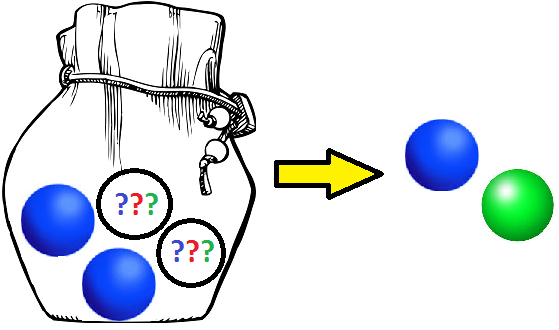Green and Blue?
A bag holds four balls. Two are blue, and the other two each have an equiprobable chance of being red, blue or green.

You reach in and pull out two balls.
If the probability of picking out a blue ball and a green ball is b a , where a and b are coprime positive integers, what is a + b ?
The answer is 34.
This section requires Javascript.
You are seeing this because something didn't load right. We suggest you, (a) try
refreshing the page, (b) enabling javascript if it is disabled on your browser and,
finally, (c)
loading the
non-javascript version of this page
. We're sorry about the hassle.
2 solutions
Nice problem. I ended up listing out the 9 equiprobable contents of the bag and then calculating the B-G probability for each.
In first case why probability is 1/6 ????
Log in to reply
Well, there are six ways to choose two balls from six, and only one of them gives you two blues. Was that the 1/6 you were asking about?
Log in to reply
Nice problem!! :]
The probability of the first ball being green is 2 1 × 3 1 = 6 1 . Then the probability for the second ball being blue is 3 2 + 3 1 × 3 1 = 9 7 So the total probability of first picking a green ball and then a blue ball is 6 1 × 9 7 = 5 4 7 and since the order of picking the balls does not matter we can multiply this by 2 (the count of variations of picking a green and a blue ball) getting the result 2 7 7 . Therefor the answer is 7 + 27 = 3 4
The probability of picking out the two balls known to be blue is 6 1 , in which case, the probability of getting a green and a blue is zero.
The probability of picking one of the known blue balls and a "random ball" is 3 2 , in which case the probability that it is a green and a blue is 3 1 .
The probability of picking the two "random" balls is 6 1 . In which case, the probability of picking a blue and a green is 9 2 since there are two ways out of nine possibilities that one is blue and one is green.
Therefore, the probability of picking a green and a blue is:
P = 6 1 ⋅ 0 + 3 2 ⋅ 3 1 + 6 1 ⋅ 9 2 = 2 7 7
7 + 2 7 = 3 4